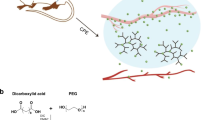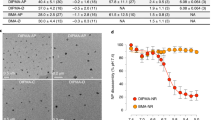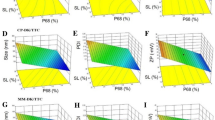Abstract
Site-1 sodium channel blockers (S1SCBs) act as potent local anaesthetics, but they can cause severe systemic toxicity. Delivery systems can be used to reduce the toxicity, but the hydrophilicity of S1SCBs makes their encapsulation challenging. Here, we report a self-assembling delivery system for S1SCBs whose design is inspired by the specific interactions of S1SCBs with two peptide sequences on the sodium channel. Specifically, the peptides were modified with hydrophobic domains so that they could assemble into nanofibres that facilitated specific binding with the S1SCBs tetrodotoxin, saxitoxin and dicarbamoyl saxitoxin. Injection of S1SCB-carrying nanofibres at the sciatic nerves of rats led to prolonged nerve blockade and to reduced systemic toxicity, with benign local-tissue reaction. The strategy of mimicking a molecular binding site via supramolecular interactions may be applicable more broadly to the design of drug delivery systems for receptor-mediated drugs.
This is a preview of subscription content, access via your institution
Access options
Access Nature and 54 other Nature Portfolio journals
Get Nature+, our best-value online-access subscription
$29.99 / 30 days
cancel any time
Subscribe to this journal
Receive 12 digital issues and online access to articles
$99.00 per year
only $8.25 per issue
Buy this article
- Purchase on Springer Link
- Instant access to full article PDF
Prices may be subject to local taxes which are calculated during checkout






Similar content being viewed by others
Data availability
The main data supporting the results in this study are available within the paper and its Supplementary Information. The raw and analysed datasets generated during the study are available for research purposes from the corresponding author upon reasonable request.
References
McAlvin, J. B., Reznor, G., Shankarappa, S. A., Stefanescu, C. F. & Kohane, D. S. Local toxicity from local anesthetic polymeric microparticles. Anesth. Analg. 116, 794–803 (2013).
Santamaria, C. M., Woodruff, A., Yang, R. & Kohane, D. S. Drug delivery systems for prolonged duration local anesthesia. Mater. Today 20, 22–31 (2017).
Kohane, D. S. et al. A re-examination of tetrodotoxin for prolonged duration local anesthesia. Anesthesiology 89, 119–131 (1998).
Lahaye, L. A. & Butterworth, J. F. IV Site-1 sodium channel blockers as local anesthetics: will neosaxitoxin supplant the need for continuous nerve blocks? Anesthesiology 123, 741–742 (2015).
Adams, H., Blair, M. Jr & Takman, B. The local anesthetic activity of saxitoxin alone and with vasoconstrictor and local anesthetic agents. Arch. Int. Pharmacodyn. Ther. 224, 275–282 (1976).
Padera, R., Bellas, E., Tse, J. Y., Hao, D. & Kohane, D. S. Local myotoxicity from sustained release of bupivacaine from microparticles. Anesthesiology 108, 921–928 (2008).
Neal, J. M., Salinas, F. V. & Choi, D. S. Local anesthetic-induced myotoxicity after continuous adductor canal block. Reg. Anesth. Pain Med. 41, 723–727 (2016).
Hofmann, P. et al. The myotoxic effect of bupivacaine and ropivacaine on myotubes in primary mouse cell culture and an immortalized cell line. Anesth. Analg. 117, 634–640 (2013).
Kohane, D. S. et al. The local anesthetic properties and toxicity of saxitonin homologues for rat sciatic nerve block in vivo. Reg. Anesth. Pain Med. 25, 52–59 (2000).
Kohane, D. S. et al. Prolonged duration local anesthesia from tetrodotoxin-enhanced local anesthetic microspheres. Pain 104, 415–421 (2003).
Rwei, A. Y. et al. Repeatable and adjustable on-demand sciatic nerve block with phototriggerable liposomes. Proc. Natl Acad. Sci. USA 112, 15719–15724 (2015).
Zhan, C. et al. Ultrasensitive phototriggered local anesthesia. Nano Lett. 17, 660–665 (2017).
Thalhammer, J., Vladimirova, M., Bershadsky, B. & Strichartz, G. Neurologic evaluation of the rat during sciatic nerve block with lidocaine. Anesthesiology 82, 1013–1025 (1995).
Zhan, C. et al. Phototriggered local anesthesia. Nano Lett. 16, 177–181 (2016).
Rwei, A. Y., Zhan, C., Wang, B. & Kohane, D. S. Multiply repeatable and adjustable on-demand phototriggered local anesthesia. J. Control. Release 251, 68–74 (2017).
Stoetzer, C. et al. Tetrodotoxin-sensitive α-subunits of voltage-gated sodium channels are relevant for inhibition of cardiac sodium currents by local anesthetics. Naunyn Schmiedebergs Arch. Pharmacol. 389, 625–636 (2016).
Nau, C., Wang, S.-Y. & Wang, G. K. Point mutations at L1280 in Nav1.4 channel D3-S6 modulate binding affinity and stereoselectivity of bupivacaine enantiomers. Mol. Pharmacol. 63, 1398–1406 (2003).
Lipkind, G. M. & Fozzard, H. A. A structural model of the tetrodotoxin and saxitoxin binding site of the Na+ channel. Biophys. J. 66, 1–13 (1994).
Kaneko, Y., Matsumoto, G. & Hanyu, Y. TTX resistivity of Na+ channel in newt retinal neuron. Biochem. Biophys. Res. Commun. 240, 651–656 (1997).
Choudhary, G., Yotsu-Yamashita, M., Shang, L., Yasumoto, T. & Dudley, S. C. Jr Interactions of the C-11 hydroxyl of tetrodotoxin with the sodium channel outer vestibule. Biophys. J. 84, 287–294 (2003).
Chen, S.-F., Cölfen, H., Antonietti, M. & Yu, S.-H. Ethanol assisted synthesis of pure and stable amorphous calcium carbonate nanoparticles. Chem. Comm. 49, 9564–9566 (2013).
Bender, M. The use of light scattering for determining particle size and molecular weight and shape. J. Chem. Educ. 29, 15 (1952).
Wasielewski, M. R. Self-assembly strategies for integrating light harvesting and charge separation in artificial photosynthetic systems. Acc. Chem. Res. 42, 1910–1921 (2009).
Chen, R. & Chung, S.-H. Mechanism of tetrodotoxin block and resistance in sodium channels. Biochem. Biophys. Res. Commun. 446, 370–374 (2014).
Lee, C. H. & Ruben, P. C. Interaction between voltage-gated sodium channels and the neurotoxin, tetrodotoxin. Channels 2, 407–412 (2008).
Tikhonov, D. B. & Zhorov, B. S. Predicting structural details of the sodium channel pore basing on animal toxin studies. Front. Pharmacol. 9, 880 (2018).
Shen, H. et al. Structural basis for the modulation of voltage-gated sodium channels by animal toxins. Science 362, eaau2596 (2018).
Ji, T. et al. Peptide assembly integration of fibroblast‐targeting and cell‐penetration features for enhanced antitumor drug delivery. Adv. Mater. 27, 1865–1873 (2015).
Ji, T. et al. Designing liposomes to suppress extracellular matrix expression to enhance drug penetration and pancreatic tumor therapy. ACS Nano 11, 8668–8678 (2017).
Ji, T. et al. Transformable peptide nanocarriers for expeditious drug release and effective cancer therapy via cancer‐associated fibroblast activation. Angew. Chem. 128, 1062–1067 (2016).
Israelachvili, J. N. Intermolecular and Surface Forces (Academic Press, 2011).
Trent, A., Marullo, R., Lin, B., Black, M. & Tirrell, M. Structural properties of soluble peptide amphiphile micelles. Soft Matter 7, 9572–9582 (2011).
Wang, H., Feng, Z. & Xu, B. Supramolecular assemblies of peptides or nucleopeptides for gene delivery. Theranostics 9, 3213–3222 (2019).
Hendricks, M. P., Sato, K., Palmer, L. C. & Stupp, S. I. Supramolecular assembly of peptide amphiphiles. Acc. Chem. Res. 50, 2440–2448 (2017).
Hartgerink, J. D., Beniash, E. & Stupp, S. I. Self-assembly and mineralization of peptide–amphiphile nanofibers. Science 294, 1684–1688 (2001).
Ortony, J. H. et al. Internal dynamics of a supramolecular nanofibre. Nat. Mater. 13, 812–816 (2014).
Micsonai, A. et al. Accurate secondary structure prediction and fold recognition for circular dichroism spectroscopy. Proc. Natl Acad. Sci. USA 112, E3095–E3103 (2015).
Greenfield, N. J. Using circular dichroism spectra to estimate protein secondary structure. Nat. Protoc. 1, 2876–2890 (2006).
Ellett, L. J. & Johanssen, V. A. In Prions: Methods and Protocols (ed. Lawson, V. A.) 27–34 (Springer, 2017).
Feldman, C. R., Brodie, E. D. & Pfrender, M. E. Constraint shapes convergence in tetrodotoxin-resistant sodium channels of snakes. Proc. Natl. Acad. Sci. USA 109, 4556–4561 (2012).
Kawatsu, K., Hamano, Y., Yoda, T., Terano, Y. & Shibata, T. Rapid and highly sensitive enzyme immunoassay for quantitative determination of tetrodotoxin. Jpn. J. Med. Sci. Biol. 50, 133–150 (1997).
Moczydlowski, E., Mahar, J. & Ravindran, A. Multiple saxitoxin-binding sites in bullfrog muscle: tetrodotoxin-sensitive sodium channels and tetrodotoxin-insensitive sites of unknown function. Mol. Pharmacol. 33, 202–211 (1988).
Ciolino, J. B. et al. A drug-eluting contact lens. Invest. Ophthalmol. Vis. Sci. 50, 3346–3352 (2009).
Lomonte, B. et al. Comparative study of the cytolytic activity of myotoxic phospholipases A2 on mouse endothelial (tEnd) and skeletal muscle (C2C12) cells in vitro. Toxicon 37, 145–158 (1999).
Slotkin, T. A., MacKillop, E. A., Ryde, I. T., Tate, C. A. & Seidler, F. J. Screening for developmental neurotoxicity using PC12 cells: comparisons of organophosphates with a carbamate, an organochlorine, and divalent nickel. Environ. Health Perspect. 115, 93–101 (2007).
Acknowledgements
Support for this work was provided by NIH R35 GM131728 (to D.S.K.) and by the Anaesthesia Research Distinguished Trailblazer Award (to T.J. and Y.L.).
Author information
Authors and Affiliations
Contributions
T.J., Y.L. and D.S.K. designed the experiments. T.J., Y.L., X.D., A.Y.R., A.O. W.Z. and C.Z. performed the experiments. T.J., Y.L., X.D., A.Y.R., S.H., M.M. and D.S.K. analysed the data. T.J., Y.L., S.H. and D.S.K. wrote the paper.
Corresponding author
Ethics declarations
Competing interests
The authors declare no competing interests.
Additional information
Peer review information Nature Biomedical Engineering thanks Matthew Webber and the other, anonymous, reviewer(s) for their contribution to the peer review of this work.
Publisher’s note Springer Nature remains neutral with regard to jurisdictional claims in published maps and institutional affiliations.
Extended data
Extended Data Fig. 1 Peptide concentration-dependent release kinetics, and nanostructures.
a) Release kinetics of ϕFFF-P1P2 + TTX formulations with TTX and different concentrations of peptides. The TTX concentration was 62.6 μM in each group. Data are means ± SD; n = 4. *p < 0.05, **p < 0.01. b) Data from panel (a) at 12 h to show relationship between peptide concentration and release of TTX. Data are mean ± SD; n = 4. *p < 0.01 vs. ϕFFF-P1P2 concentration at 62.6 µM. c) Representative TEM images showing the effect of the concentration of ϕFFF-P1P2 on morphology. The dashed red circles and yellow arrows indicated aggregations. Scale bar: 100 nm.
Extended Data Fig. 2 Laser scanning confocal microscopy of the fluorescence of Alexa- ϕFFF-P1P2 and Alexa-P1P2 injected at the sciatic nerve in rats.
Representative images are of sciatic nerves and surrounding tissues collected 15 min and 24 h after injection. Red: Alexa647, indicating formulations; blue: HOECHST33342, indicating nuclei.
Extended Data Fig. 3 In vivo data for saxitoxin, free and in ϕFFF-P1P2 (ϕFFF-P1P2 + STX).
a) Duration of sensory nerve blocks. Data are means ± SD; n = 4. b) Thermal latency in the uninjected (contralateral) extremity in the first 5 h. In both panels, the ϕFFF-P1P2 concentration was 626.4 μM, and the ratio of ϕFFF-P1: ϕFFF-P2 = 1:1. The STX concentration is as shown in the figures. Data are means ± SD; n = 4.
Extended Data Fig. 4 Tissue reaction to STX and dcSTX formulations 14 days after administration.
Scale bar for H&E-stained sections: 100 μm; for toluidine blue stained sections: 25 μm.
Supplementary information
Supplementary Information
Supplementary discussion, figures and tables.
Source data
Rights and permissions
About this article
Cite this article
Ji, T., Li, Y., Deng, X. et al. Delivery of local anaesthetics by a self-assembled supramolecular system mimicking their interactions with a sodium channel. Nat Biomed Eng 5, 1099–1109 (2021). https://doi.org/10.1038/s41551-021-00793-y
Received:
Accepted:
Published:
Issue Date:
DOI: https://doi.org/10.1038/s41551-021-00793-y
This article is cited by
-
Long-lasting postoperative analgesia with local anesthetic-loaded hydrogels prevent tumor recurrence via enhancing CD8+T cell infiltration
Journal of Nanobiotechnology (2023)
-
Aromatized liposomes for sustained drug delivery
Nature Communications (2023)
-
An aptamer-based depot system for sustained release of small molecule therapeutics
Nature Communications (2023)
-
Perspectives and trends in advanced optical and electrochemical biosensors based on engineered peptides
Microchimica Acta (2023)
-
An unruly painkiller is tamed with inspiration from nature
Nature (2021)



